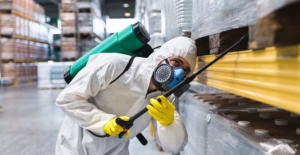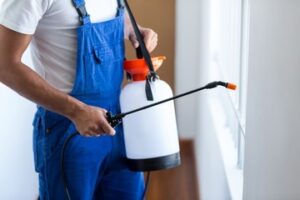Wildlife Control Plano is the treatment and extermination of nuisance wild animals, including raccoons, opossums, squirrels, skunks, groundhogs, and birds. A WCO must be licensed to trap and may be permitted or certified to use regulated toxicants.
Integrated Wildlife Damage Management is the timely use of various cost-effective methods to reduce wildlife damage to a tolerable level.

Wildlife control focuses on the trapping and removal of nuisance-causing animals such as raccoons, possums, skunks, groundhogs, birds, and more. This is a niche skill within the pest control industry that should be left to experts who are trained and experienced in resolving wildlife issues without harming the animal.
Nuisance wildlife can damage property or pose a health risk to humans and pets through the spread of zoonotic diseases such as rabies, herpes B, and hepatitis A. They can also be a fire hazard, cause structural damage to buildings and structures, and create unsafe environments by chewing or scratching at materials. Wildlife control specialists work with homeowners to remove unwanted wildlife from their homes and properties. They may set traps and monitor them for a few weeks while waiting for an animal to be trapped, and they will take steps to ensure the creature does not return to your home in the future.
In addition to trapping and removing unwanted wildlife, wildlife removal professionals perform exclusion work on the property to keep wildlife from coming back. They will seal any open entry points, repair any wildlife-related damage to your home, and eliminate food sources that attract wildlife. This process can be complex and extensive, but it is crucial to prevent wildlife from returning to your property and creating further problems.
Many people believe that shooting is the best solution for removing wildlife, but this is not always safe or legal. Many states and communities have laws that prohibit the discharge of bows and firearms near houses, and some areas are completely prohibited from hunting. Depending on the situation, it is best to leave the removal of wild animals to wildlife control experts who are licensed and insured.
Private wildlife removal companies are often called when an issue is above and beyond the scope of what animal control can handle. For example, if you have bats in your attic, animal control will not help you, but a private company will. You can call the non-emergency police for your county to be referred to a local private company or find one on your own.
Exclusion
While pest control generally refers to the eradication and treatment of insect infestations, wildlife exclusion is designed to prevent animal access to homes and businesses. It involves sealing cracks, holes and openings around windows, doors, walls, foundations and soffits so that even the smallest of animals cannot get in. It may also involve fixing any damage caused by the pests, as well as securing or replacing anything that they have chewed through to make their way inside.
Wildlife exclusion is usually offered as a preventative, add-on solution to existing pest control services. By educating customers about the most common entry points for wildlife into their home, you can help them take measures to seal these off and prevent future issues. Chimney caps and screens, plumbing vent covers, gable and dormer vents and soffit vents can all be fitted with special wildlife exclusion products to stop raccoons, squirrels, birds, mice, groundhogs, opossums, rodents and other critters from entering.
Adding wildlife exclusion as an additional service helps your company differentiate itself from the competition and offers you a way to grow revenue. While most pest control companies charge monthly or annual fees, your wildlife exclusion devices are one-time solutions that will raise average ticket prices while providing you with a steady stream of new customers.
The good news is that the equipment and materials needed for wildlife exclusion are relatively inexpensive compared to pest control tools. In addition, most pest control professionals already have the necessary skills to offer this type of service. They are familiar with local critter and pest behavior, the common spots where wildlife enters homes and how to prevent it, and they have an excellent understanding of the local laws and regulations pertaining to wildlife.
It is important to find a wildlife exclusion company that prioritizes humane methods for the safety of people and animals. Also, ensure that they have experience and are licensed and insured before hiring them. This will minimize your risk of dealing with an unlicensed and potentially dangerous wildlife removal company. Also, look for a company that specializes in the specific type of critter you need to remove from your property.
Trapping
A trap is a body-gripping metal or wood device that is designed to close on the neck and/or torso of an animal when the trigger (usually a pair of wires) is pulled. There are many types of traps, ranging from simple cage traps to elaborate snares that can be modified for specific species and purposes. Trapping requires specialized knowledge of the biology, behavior, and sign of various species along with training in trapping techniques, humane dispatch methods, and animal handling and containment procedures. It also involves compliance with state and federal wildlife laws, trapping seasons, and regulated toxicant use.
In general, trapping is a common form of nuisance animal control, but it can also be employed as part of a management program to manage wild animals, their populations, and their habitats. For example, some fur trappers rely on a network of traps and snares to control the population of invasive species that pose a threat to native ecosystems. Others may be tasked with controlling nuisance wildlife, including invasive species and predators that cause damage to crop fields, gardens, and homes.
Trapping can be a very difficult and dangerous occupation for those who do not have the proper equipment and skills. It is also a highly regulated activity, requiring state and federal trapping licenses, adherence to specific trapping season dates, and regular inspection and record keeping of catches.
In addition, trapping wildlife can be complicated by the fact that it is often necessary to take into account animal behavior and health, the needs of dependent young, and the effects of human actions. For example, during spring through fall, squirrels, raccoons, possums, groundhogs, and other animals frequently choose locations in and around homes, sheds, and decks to raise their young. If trapped and relocated to a remote natural area, these young animals are likely to starve and will probably die. Therefore, it is important for those who are concerned with the welfare of wildlife to work only with a wildlife damage control operator who is licensed and certified to ensure that all animals are treated humanely and in accordance with state and federal wildlife regulations.
Translocation
The relocation of an animal from one area to another outside of its home range is a common tool for wildlife management. This is often done to prevent a species from becoming extinct or to restore ecological function that has been lost due to human pressures, such as habitat loss or predator reduction.
A variety of different factors can influence the success or failure of a translocation program. The authors of the Global Re-introduction Perspective Series identified over 1200 difficulties that have been experienced in this popular conservation tool and provided insight into what makes or breaks these efforts. These problems were categorized more or less evenly into intrinsic difficulties related to the biology of the reintroduced species, external difficulties stemming from the biotic, physical or socio-political environmental conditions and logistical or administrative difficulties.
Many of the reintroduced animals experience behavioral issues that can hamper their chances for survival. This problem is most prevalent when the reintroduced species encounters novel environments in which they have little or no evolutionary experience. These new environments may be a part of the natural landscape where they have been released or part of a protected area that has been set aside as their habitat.
Other behavior-related issues that contribute to the overall difficulty of translocations include dispersal away from the release site, which reduces the probability of survival (e.g., reintroduced bush stone-curlews that dispersed too far and starved to death; Kemp & Roshier, 2016) or unnatural foraging behavior that limits the fitness of the reintroduced animals (e.g., reintroduced Hawaii creeper that failed to forage in ways native to the islands; Kohley & Lockyer, 2008).
The number of wildlife species in an ecosystem largely depends on available habitat. However, habitat degradation is a major threat to most animal populations and can result in their extinction or reductions in abundance. Wildlife conservationists are increasingly turning to translocation as a way of boosting the numbers of endangered animals. However, as habitat destruction and hunting continue to increase, the need for an integrated wildlife control strategy is growing. Licensed NWCOs are trained to handle and relocate wild and nuisance animals, and have the skills necessary to do so safely and effectively.
